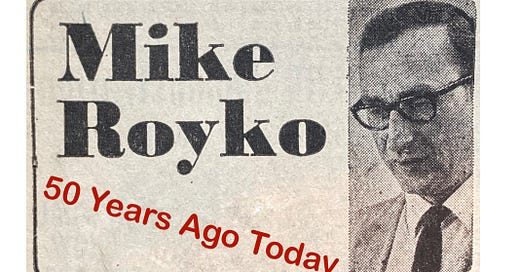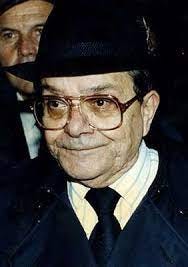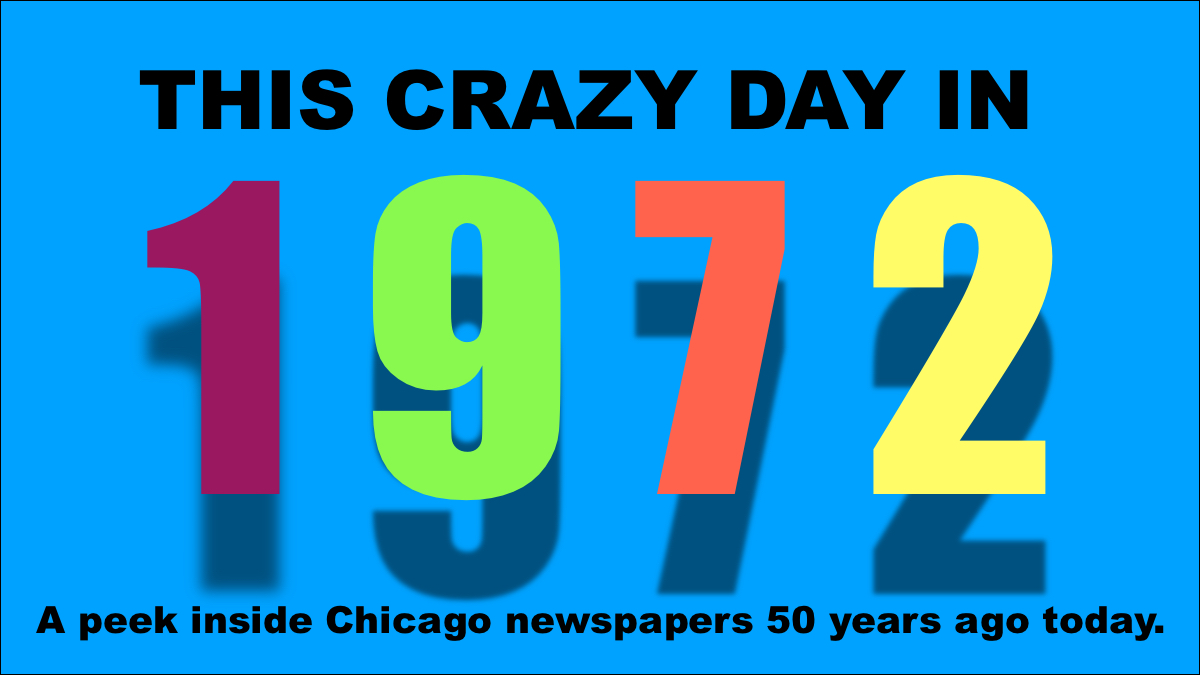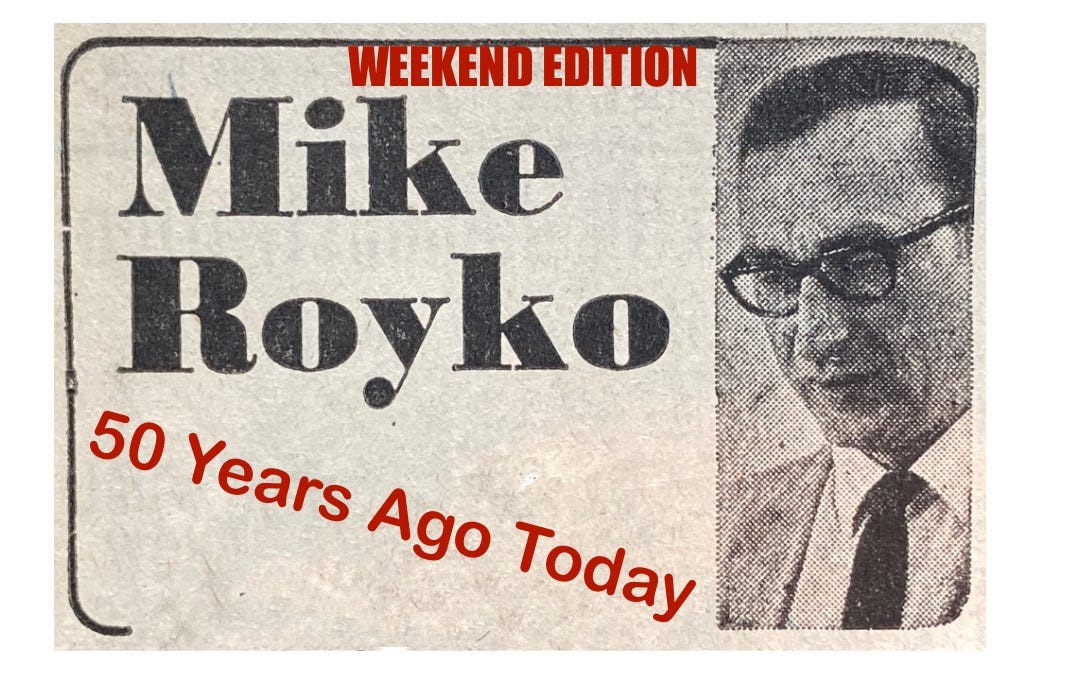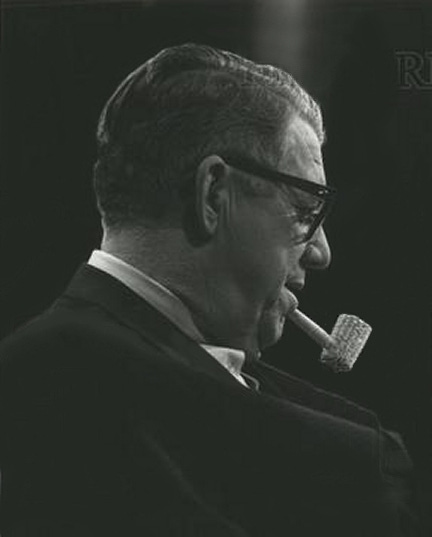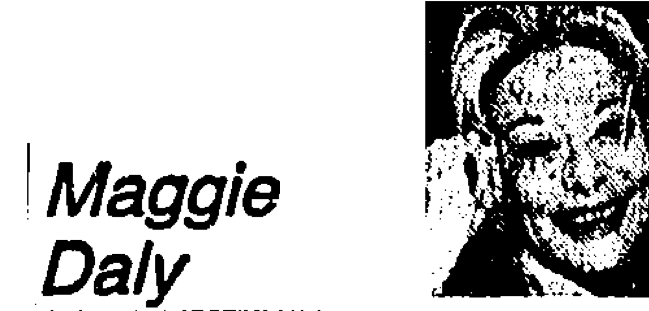Mike Royko 50 Years Ago Today: If only George Carlin could do the audio version
May 15-21, 1972
To access all site contents, click on the rose icon in the upper left corner or HERE.
Why do we run this separate item, Mike Royko 50 Years Ago Today? Because Steve Bertolucci, the hero of the serialized novel central to this Substack, “Roseland, Chicago: 1972,” lived in a Daily News household. The Bertoluccis subscribed to the Daily News, and back then everybody read the paper, even kids. And if you read the Daily News, you read Mike Royko. Get your Royko fix on Twitter too— @RoselandChi1972.
May 15, 1972
This is the kind of trenchant socio-political commentary disguised in humor that literally could have been done, precisely when it was written, by George Carlin. Carlin at that moment was at the high point of his new hip political phase. It’s so easy to imagine Carlin doing this in two character voices—the lawyer reading a will and the ambivalent beneficiary.
Since this gives me the excuse to do so, here’s George Carlin on Dick Cavett when his album “FM & AM”came out. Cavett is also a prominent 1972 personage. He just won an Emmy for best talk show in our 1972 timeline at THIS CRAZY DAY IN 1972. For the best coverage of the 1972 Emmys, see Bruce Vilanch’s TV Report from Chicago Today in a May 15 item.
Back to Mike.
This column finishes with possibly the best one-word closer of Mike’s career. I’m not worried about overselling that.
Also: I could be wrong, to quote half of the title of Mike’s second book, but I’m not seeing this column included in any of his book compilations. If so, this is an extra special treat. There’s just nothing like reading an iconic Royko column for the first time, or the first time in 50 years. Like catching “Casablanca” on TV by complete accident before VCRs, DVDs and streaming. Older Readers know exactly what I mean.
Historical context for Younger Readers: Vietnam War. Please look it up on Wikipedia so the rest of us don’t have to go through it again.
This column is all dialogue. So, rather than confuse you with double quotes all the way through, just know that everything that follows is from the column. I’ll excerpt several key points, starting with the lede. Ellipses in between.
“If you will be seated, sir, I will read the will.”
“Will this take long?”
“Not at all, Mr. President.”
…
“To tell the truth, I didn’t even know a will was involved.”
“There has to be a will, sir. The new administration always inherits various things from the outgoing administration. And that wouldn’t be legal without a will….. ‘And I do bequeath unto my successor, the mounting inflation, rising unemployment and, of course, the war.’”
“The what?”
“The war.”
“Wait a minute, I don’t want that thing.”
“But you have inherited it, sir.”
…
“Then what do I do with the thing?”
…. “You can always make it smaller—wind it down, as they say. Then you will be praised as a man of peace who is extricating us from a difficult and tragic situation.”
“That sounds good.”
“Or you can make it bigger—escalate it, as they say. Then everyone will rally around you, as is the tradition, and hail you as a man of courage who must make agonizing decisions in the world’s loneliest job….Or another excellent approach is to wind it down and escalate it at the same time. This is done by adding more ground troops while increasing the bombing.”
…
“Well, I’ll tell you what I think. It’s a lot of bother for such an old war.”
“True. Which leaves you another option….You can trade it in for a newer and bigger one.”
“That’s a thought. We’ll have to talk about that. Say, what’s your name?”
“Henry.”
“What do you do around here, Henry?”
“This.”
Henry Kissinger information is easily available, of course. For 1972 news background on Kissinger, see May 5 for excerpts from a series of hagiographical articles on Kissinger in the Daily News; here on April 25 for his secret trip to Moscow; and January 26 for news breaking on Kissinger’s secret Paris talks with the North Vietnamese. He was a very busy boy. And he isn’t even Secretary of State yet.
This week, follow the rabbit in Mike’s Weekend Edition, last item.
May 16, 1972
BAM. Many hearts sank when they turned to page three today.
When Mike took a day off, a logo like this would appear instead of the column. Sometimes, like today, the paper would add an extra dollop of weirdness by putting Mike’s column header at the bottom of the page. So in addition to the disappointed bafflement when you turned to page three and did not see Mike at the top, there was the additional jolt of seeing him at the bottom of the page where he was not supposed to be at all.
May 17, 1972
Even with now notorious Illinois Secretary of State Paul Powell six feet under—and $750,000 in small bills subsequently. found in his hotel room closet, much of it in a shoebox—Mike finds it’s still pretty easy to get a driver’s license with a bribe. (Note: That was only part of Powell’s stash, but it’s $5 million in 2022 money. Quite a lot of small bills. Consider how many big oil barrels Walter White buried in the desert to hide his $10 million.)
BTW, a good place for Younger Readers to catch up with Paul Powell is the Jan. 1-2 story in the Daily News headlined “Shoe-box scandal one year later.” He’s the most corrupt caught Illinois politician of the mid-20th century, and a continual contemporary punchline.
Mike recruits a female Daily News reporter to give a precinct captain $50 ($337 in 2022 money) to pass on to his pal Joey, a driving examiner at the Secretary of State testing site at 5301 W. Lawrence. That site, below, is a closed strip mall in a 2021 Google Streetview shot. It looks like it used to be a Walgreens.
The undercover reporter does an amazing job. Can anyone let us know who it was? There are several terrific female bylines in the Daily News by 1972, so it’s not immediately obvious. If anyone knows, please reveal in comments, or email RoselandChicago1972@gmail.com.
The precinct captain, called “George” for the column, drove the undercover reporter to the testing site. She made conversation with George that resulted in some of the most classic Machine flunky quotes I’ve ever read. It’s a joy to imagine how she kept this guy talking with wide-eyed, innocent interest, jotting down his quotes as soon as she left, or maybe using a hidden tape recorder.
On the way, [George] bragged about how much money his pal, the driving examiner, makes. “He makes more on the side from this than he does from his salary.
“You should see ‘em with the Puerto Ricans. They touch a line [with the car] and they’ll say, ‘OK, that’s it, you fail.’ Then the guy’ll say, ‘But Senor, I need my license.’ Then they’ll say: ‘Oh, you need your license, hey? How much is it worth?’
“Sometimes when a guy just offers ‘em a bribe, they might turn ‘em in, to look honest. But then they keep the next 10 bribes.”
Just before George the precinct captain hands off the undercover reporter to Joey the driving examiner, George says to her, “By the way, do you know how to drive?”
During the examination drive, the reporter “intentionally drove over several lines, made one screeching stop, drove too fast and said she didn’t know how to park a car….At one point, she headed for a curb. Joey grabbed the wheel and straightened the car out before they hit.”
I hope she got a nice bonus for this.
Joey gave Mike’s reporter pal an average score. “That’s a pretty good score for a girl,” he said.
May 18, 1972
Last month, Channel 11 decided to start televising City Council meetings, and Mayor Daley said OK. Yesterday’s Council meeting was Ch. 11’s first live telecast. Mike found it disappointing.
It’s Ch. 11’s fault, writes Mike, for taking the whole thing seriously.
“The anchorman sat in his glass booth and talked of parliamentary procedure, Robert’s Rules of Order, and such niceties. They are as relevant to the Council as the Queensbury Rules of Boxing are to a back-alley mugging.”
The Ch. 11 anchor missed the good stuff, of course. For instance, he “ignored the arrival of a former alderman, the portly John D’Arco, who is part of the Chicago crime syndicate.
“D’Arco, the 1st Ward boss, dropped in to have a few words with Ald. Fred Roti, from his ward.
“His cigar jammed three inches into his mouth, D’Arco swaggered into the chambers waving and winking, his diamond ring twinkling.
“‘Hiya Keed,’ Ald. Willie Cullerton cried out to him.
“As D’Arco sprawled across Roti’s desk, a visitor asked Ald. Stanley Zydlo who D’Arco was.
“‘That’s John D’Arco,’ Zydlo said. ‘He’s Roti’s ‘chinaman.’
“He doesn’t look Chinese, the visitor said.
“‘That doesn’t mean he’s Chinese. That means he is Roti’s boss.’”
Although this isn’t Mike’s closer, it could have been:
“What could have been a more educational interview than that for an educational TV station?”
For Younger Readers: The term “chinaman” is an old Chicago political term for “the person with clout (political influence) who got you your job.” No one knows the origin of the term, already in use by the early decades of the 20th century. It’s generally used in print without a capital “C”—which is another way to distinguish it from a reference to someone’s national origin. It was not considered racist during the 20th century, or even impolite. Those using the term literally did not think of it in relation to the country of China or anyone from that country.
As the Tribune’s City Hall reporter noted in his account of the televised Council meeting (see this week’s THIS CRAZY DAY on May 18), the aldermen dressed very differently than usual. But the Trib missed Ald. Vito Marzullo’s “spiffy striped jacket” and his comment to reporters, both savored by Mike:
“I got it for nuttin’. I’m an alderman. I don’t pay for my clothes.”
If you dig Mike Royko, you’ll want to see the news he’s writing about. Check it out here!
May 19, 1972
Here comes the stressful story of Dianne and Jim Adomaitis, who need to sell their house because they have to move for Jim’s job.
Their house at 1823 W. 51st is not, as Mike says, a mansion. But he goes through it several times and finds it clean and well-maintained—both the upstairs, where the Adomaitis family lives, and the downstairs flat.
Dianne and Jim live in a neighborhood “where the homes are older” and “a bank won’t give a mortgage unless it is insured by the Federal Housing Administration.” The house is at the corner of Honore and 51st, in Back of the Yards.
The FHA won’t insure a mortgage without approval of the city Building Department. Royko readers know what that means: building inspectors. And where there are building inspectors, there will be bribes.

The first building inspector tells Dianne and Jim that the first-floor flat is illegal, even though it’s been there for 50 years and has front and rear exits, because nobody applied for a permit when it was originally converted. He says they can only get approval for a single-family house—after they tear out everything in the basement flat, including the walls.
The real estate agent comes back and tells the Adomaitis’s that the inspector really just wanted a $250 bribe. They procure the money. Let’s be clear that this was a serious commitment. It’s $1,687.50 in 2022 money. But then a new inspection date miraculously brings a different inspector who says the house is fine, and with no bribe! But then a third inspector shows up unannounced and says he sees rats, plus the house is an illegal two-flat. Inspector #3 says they’re going to court.
As Mike notes in his closer:
“That’s life in the one city that really works.”
May 20-21, 1972
As we here all know, weekends could be sad for a Daily News family because Mike Royko wasn’t in the Daily News’ single weekend edition. So we look for Mike elsewhere on weekends.
Whatever else you think about Mike Royko, we know Mike was no pushover. You would never have seen a fawning book jacket blurb from Mike Royko included in SPY Magazine’s regular “logrolling” item mocking the exchange of back-scratching, over-the-top plaudits from one author to another.
So these ads caught my eye.
Chicago Daily News, May 2, 1972:
Chicago Defender, May 3, 1972:
Who the heck was Harry Homewood?
Turns out Harry Homewood must have been one of the more interesting newspaper people Mike Royko met in his career, because it’s tough to get more interesting than Homewood’s bio on his Amazon author’s page:
Harry Homewood was a qualified submariner before he was seventeen years old, having lied to the Navy about his age, and serving in a little "S"-boat in the old Asiatic Fleet. After Pearl Harbor he reenlisted and made eleven war patrols in the Southwest Pacific. He later became Chicago Bureau Chief for Newsweek, chief editorial writer for the Chicago Sun-Times, and for eleven years had his own weekly news program syndicated to thirty-two PBS television stations.
You don’t get much cooler than that, despite the corncob pipe in the picture below. Stay tuned for input from legendary Chicago political consultant Don Rose, who will weigh in farther down.
As far as I can find in the Daily News and Tribune digital archives—the accessible Sun-Times digital archive doesn’t start until after Mike’s stint there—Mike Royko never mentioned Harry Homewood in his column.
Rummaging in the newspaper archives, I see Harry Homewood’s first Chicago clipping came in 1957 via Herb Lyon’s Tower Ticker column in the Tribune:
Per Homewood’s 1984 Tribune obituary, his legal name was “Charles H. Homewood.” He died at 70 after retiring to Arizona with his wife five years earlier. We know from Herb Lyon that Homewood jumped from editing at McGraw Hill to Newsweek. It’s unclear if Homewood had a newspaper background prior to that. (Herb Lyon, by the way, is father of Chicago Today reporter Jeff Lyon, whose articles are often included in THIS CRAZY DAY IN 1972 because they are irresistible regardless of the topic.)
In Chicago, Homewood moved to the Sun-Times in 1962 as an editorial writer, where he remained until 1970. He’d already begun hosting the weekly news discussion program “Fact of the Matter” on Channel 11 in 1961, which he also continued until 1970. The show was syndicated to 32 other PBS stations.
Here’s the very first TV guide listing for “Fact of the Matter” in the Daily News, from June 1, 1961. You can tell the show was in black and white because only a few shows had the word “COLOR” in all caps preceding their titles, such as “The Tonight Show” with Johnny Carson.
You can also tell from the listing that Harry Homewood was just as brainy as Mike Royko attested in the ads for Homewood’s WAIT radio show.
Homewood left the Sun-Times in 1970 to become WAIT’s news director, which included presenting a news commentary daily.
Here’s one of the first WAIT ads for Homewood’s radio show, from October 1970:
Homewood must have been close friends with Tribune columnist Bob Cromie. Cromie didn’t just give Harry a blurb for radio display ads—he mentioned Harry quite a few times in his columns.
I’d say the most interesting Cromie mention came almost exactly 50 years ago, coincidentally. On May 3, 1972 Cromie wrote one of his occasional columns where he talks with his own Slats Grobnik type character, named “Milton Milton.” Milton Milton is also somewhat dimwitted but sometimes unexpectedly drops common sense.
“The other morning,” said Milton Milton, “I am listening to Harry Homewood, which is one of them news analysts on WAIT, and he says if the North Vietnamese wish to embarrass the President seriously all they got to do is ship our prisoners home and say: “NOW will you get out of Hindu China?” This Homewood, which seems to be a pretty smart cookie, says he is surprised the Commies ain’t thought of this already.”
But let’s get back to Harry Homewood’s books. A 1981 Tribune article by Carol Kleiman on how the amazing new phenomenon of home computers is revolutionizing life for professional writers quotes Homewood, already retired and writing novels in Tuscon: “It’s the greatest thing since corrective typewriters,” Homewood told Kleiman. “My productivity has increased about 30 percent and my style is unaffected. And there are tax advantages. Word processors can be written off.” FYI, Homewood’s computer cost $7,000 at that time. That’s $22,260 in 2022 money.
Kleiman wrote that Homewood had written 14 books at that time, which seems unlikely. His Tribune obituary says he wrote seven books, with one unpublished at his death, while his Amazon author’s page lists six novels, all available now on Kindle from Thunderchild Publishing. Five are novels involving submarine warfare and/or international intrigue.
But the first one from 1975— “A Matter of Size”— features Fred Hennessey, “deadly former agent” who, we learn just a page or so into Chapter 1, is currently working as an editorial writer at what is the unnamed Sun-Times. The book opens with agents, clearly meant to be with the CIA, meeting to discuss a case. They’re in a Wacker Drive highrise office, considering whether to use Hennessey on the case. The guy in charge explains: “About Hennessey. He writes editorials for that newspaper you can see there across the river, if you look out the window.”
Today, the agents would see Trump Tower when they looked across the river. But in 1975 it was the Sun-Times/Daily News Building.

Here’s the Amazon summary for “A Matter of Size”:
How were the Russians getting a sophisticated electronic component that could only be designed and built by a handful of men — all living in the United States? Even more puzzling, how would it be exported? Hennessey, a tough, resourceful, deadly former agent, is summoned to undertake this important, but dangerous, assignment. Hennessey narrows the search to a small electronics shop owned by a man named Andress and discovers Andress’ wife and child are gone. Were they being held hostage until the job was done? Hennessey must find the kidnappers to discover who is behind this espionage scheme.
I don’t have access to the Sun-Times digitally prior to 1986, but I’ll update if I later find something there on Homewood and his books or radio show. From the Tribune and Daily News archives, it seems Harry Homewood didn’t get much publicity for his first book, except one item from gossip columnist Maggie Daly in the Tribune. Note that Maggie Daly IDs Homewood as “former bureau chief here for Newsweek” even though that job ended in 1962, over a decade earlier, rather than calling Homewood a former editorial writer for the Sun-Times. God forbid the Tribune should print the name of a rival in its pages if it could be avoided.
I haven’t had a chance yet to read more than the first few pages of “A Matter of Size,” but Homewood presents just the kind of sweaty, dirty, hard-boiled Chicago you’d expect in the ‘70s:
“Summer can be worse than winter in Chicago. In summer the wind comes across the heated plains to the west of the city or it angles in from the southeast picking up clouds of pollutants from the belching stacks of the steel mills of Gary and Hammond….It was a typical August day in Chicago. The Chicago River lay slack under a brassy sun, garbage and used condoms floating on its greasy surface. Two men, their faces glistening with sweat, got out of a cab in front of a tall office building on Wacker Drive and walked into the air-conditioned chill of the building’s lobby.”
No disrespect, but this does remind us that Homewood is not from Chicago, or he would not have forgotten the still formidable pollutants pumping out of the East Side in the early ‘70s. That aside, the book and Hennessey’s cover as a Sun-Times editorial writer look highly entertaining. The Amazon’s Kindle version is free with the Kindle Unlimited program, or $2.99.
Legendary political consultant Don Rose met Homewood when Rose joined WAIT in 1971, doing his own radio show called “Problems of the City” and other promotional work for the station. Don confirms that Harry Homewood was well known in Chicago, and was brainy as he looks with that corncob pipe. But what Don mainly remembers is a few scenes from “A Matter of Size,” a book he enjoyed:
“There was an odd scene,” says Don, where Fred Hennessey “got somebody to talk by tying him up and tying something around his nuts. And he [Hennessey] was gonna leave him and says, ‘Well, if you think of it and tell me, with any luck it’s before they dry up and fall off because of this noose I’ve got around them’ or something like that. You see why it’s a vivid memory.”
However, as mentioned, the rest of Harry Homewood’s books center on war, mostly via submarine warfare. And from reading the summaries and short excerpts, it sounds like Homewood brings his prodigious submarine experience to bear much like Melville’s whaling informs “Moby Dick.”
The dedications and prologues to Homewood’s other books are serious, heartfelt, and moving. “Final Harbor” is dedicated “with profound respect to the memory of the 3,508 officers and enlisted men who died in the sinkings of 52 United States Navy submarines in World War II, some of whom I had the pleasure of serving with before their deaths.”
“O God of Battles” is dedicated “with respect and affection to Rear Admiral Maurice W. ‘Mike’ Shea, USN (Ret.), a fighting submarine captain who would sail to hell and back and laugh all the way.”
The prologue to “Silent Sea” gives a thumbnail sketch of the evolution of American submarine warfare after the Japanese bombing of Pearl Harbor, explaining that by April 1945, “the U.S. submarine force in the Pacific had so tightened the noose of naval blockade around Japan’s throat that the enemy was finished as an industrial nation, unable to fight a war effectively….
“The American submarines paid dearly for their victory over Japan. One of every five men who went to sea in submarines in the Pacific died in combat, the highest percentage of casualties of any branch of the U.S Armed Forces.”
According to Homewood’s Tribune obituary:
“Arrangements were being made to fulfill Mr. Homewood’s request to have his ashes scattered over the south Pacific Ocean.”
By the way, this feature is no substitute for reading Mike’s full columns. He’s best appreciated in the clear, concise, unbroken original version. Mike already trimmed the verbal fat, so he doesn’t need to be summarized Reader’s Digest-style, either. Our purpose here is to give you some good quotes from the original columns, but especially to give the historic and pop culture context that Mike’s original readers brought to his work. You can’t get the inside jokes if you don’t know the references. Plus, many columns didn’t make it into the collections, so unless you dive into microfilm, there are some columns covered here you will never read elsewhere. If you don’t own any of Mike’s books, maybe start with “One More Time,” a selection covering Mike’s entire career and including a foreword by Studs Terkel and commentaries by Lois Wille.
Do you dig spending some time in 1972? If you came to MIKE ROYKO 50 YEARS AGO TODAY from social media, you may not know it’s part of the book being serialized here, one chapter per month: “Roseland, Chicago: 1972.” It’s the story of Steve Bertolucci, 10-year-old Roselander in 1972, and what becomes of him. Check it out here.
To get MIKE ROYKO 50 YEARS AGO TODAY in your mailbox weekly along with THIS CRAZY DAY IN 1972 and new chapters of the book—
SUBSCRIBE FOR FREE!

